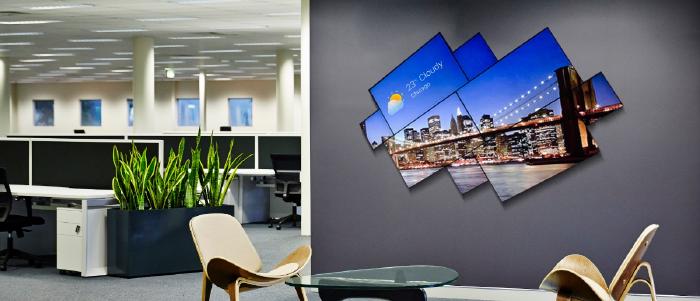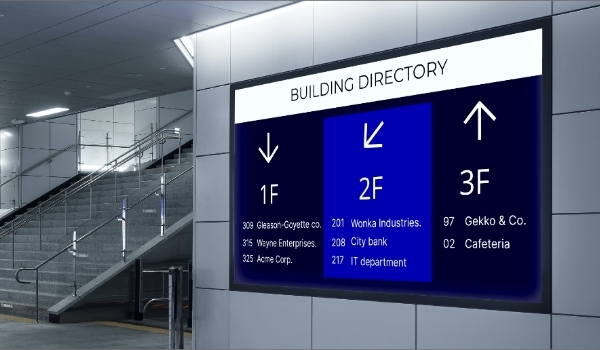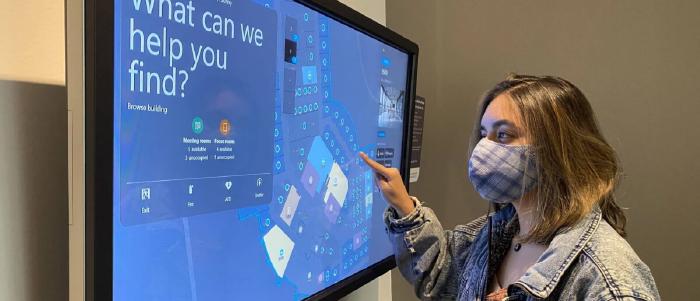
Aug 9 2022
8 min read


Apr
You are in a giant co-working space, unable to figure out the office you intended to visit. There are no clear signs that indicate which floor or space it is at, leaving you confused and flustered for directions. This is where wayfinding steps in.
Gone are the days when we solely relied on asking for directions or following static signs. The digital age has reshaped our navigational expectations.
The digital wayfinding industry is on an upward trajectory, poised to hit a remarkable US$ 664.95 million valuation by 2028. This surge highlights the growing preference of businesses for contemporary navigation solutions. As e-signs become an integral part of modern infrastructure, understanding its nuances is essential. And this blog is just the right one for you. Read on.
Wayfinding digital signage refers to integrating modern technology with traditional navigation methods to guide individuals seamlessly through a specific environment. These utilize electronic displays to provide real-time directions, maps, and information, enhancing the user’s navigational experience. One way of putting digital wayfinding into practice is by installing interactive kiosks at various business locations.
At its core, this technology is simple. However, to enhance user experience, the software can be tailored with features like touch and touch-free interactions and dynamic ‘follow-me’ maps. Additionally, QR codes can be integrated, allowing visitors to access building maps directly on their smartphones.
Digital wayfinding signage operates by seamlessly blending advanced technology with user-centric design. At its heart, it employs display screens powered by specialized software to present navigational information. The software manages the screen’s content and can connect to the internet for real-time updates.
The system often integrates advanced features such as touch-responsive interfaces, voice commands, and gesture recognition to enhance user interaction. These innovations make navigation more intuitive and cater to diverse user preferences, ensuring a seamless and personalized experience.
Try For FreeYou can use digital wayfinding signage in several ways as per your needs and preferences. However, there are mainly 3 types of it. Let us know them better.

Digital directories in office lobbies fall under the umbrella of static wayfinding solutions. These wayfinder signs are inexpensive and aid your visitors with a simple reference point. Just display a graphic layout of your campus or building highlighting all the facilities and departments.
You can also use a dynamic QR code generator for the electronic map and help visitors scan it using their mobile devices and access the directory easily on the go.
Want to know more about the digital building directories? Read this blog
Interactive signs allow visitors to interact with a digital screen to quickly understand how to go from point A to point B. And it happens, of course, with the help of touchscreen technology. With touch screen wayfinding , you will offer a personalized experience to your visitors.
They need to touch the destination name on the screen or search for it by typing in the search bar. Immediately, they will get a visual demonstration of how to reach the place from their current location. It will show the exact route, saving the visitor the precious time he would otherwise waste on guesswork.
Digital solutions, such as interactive wayfinding displays, offer an engaging map presentation method. This enables users to filter and discover precise routes with ease.
You can also opt for 3D signage that allows dynamic functionality. With this sort of digital wayfinding , you can offer a realistic view of your campus. It will take your overall brand image up a notch.
Here’s a video explaining how an interactive 3D kiosk functions.
Portable wayfinding signage refers to mobile navigational tools adaptable to various environments. Unlike fixed signs, portable solutions can be easily relocated to meet changing needs. With the advantages of wireless connectivity and robust battery life, they provide unparalleled content management flexibility, ensuring that individuals navigate seamlessly, whether at transient events or in ever-changing environments.
Providing digital directional assistance to visitors results in beautiful benefits, and we will discuss that briefly.
And for those fantastic benefits, it is hard-pressed for any industry to refrain from using digital wayfinding signs. Here, we have listed the ones where digital wayfinding signage has already found its application and proven its worth.
Corporate Headquarters
Healthcare sector
Hotels & Resorts
Shopping Malls
Airports & Railways
Education sector
Government buildings
Stadiums
Convention centers
Amusement parks
Residential complexes
It is likely to make mistakes. Hence, learning about some best practices is essential. Let’s have a glance at them.
Keep only the required details. Make sure your maps are manageable for visitors.
Keep things simple. Complicated terms may need to be clarified for your guests. For example, using ‘cloakroom’ instead of ‘washroom’ or ‘toilet’ will be confusing. Avoid it.
Choose your color codes wisely. All your screens must ally with each other with a similar brand voice.
Use universal symbols for every location. Creating creative symbols and signs is cool only if your guests decode them correctly.
Place the screens effectively. If you keep them in a location that is out of sight for most visitors,it is likely to be as good as useless. Think twice before the final placements.
The potential of signage technology is enormous. You can bend and customize the benefits it provides according to your audience. Have a look at the few significant advantages here.
Digital wayfinding streamlines navigation. For instance, travelers can quickly locate their gates at large international airports, reducing missed flights and enhancing overall airport efficiency. Businesses would only like to spend what is needed to improve customer experience.
Imagine how hectic it is to find the pediatrician’s chamber on a hospital campus. And if the question is not about which floor first but which building, it is a frustrating and time-consuming task for the visitor. He may miss the appointment in the process of finding out the correct location!
And the people you have hired to help your visitors with wayfinding cannot handle every situation smoothly. Why? The number of people on the other side (the visitors) is enormous. By implementing digital wayfinding signage, you help these people save their precious time. And when you save your employees’ time, they can concentrate on more critical work and boost productivity.
TAt shopping malls equipped with the latest technology, kiosks allow shoppers to search for specific stores or amenities, tailoring their shopping experience and reducing frustration.
It means you are helping them navigate the campus independently, using a digital screen they are used to operating and knowing every functionality. Hence, they find it highly convenient and comfortable to use. Also, if you have kept these screens interactive, you will surely please your visitors a hundred times more than static digital displays with the simple building directory.
When you install touchscreen kiosks for wayfinding solutions, your guests are super satisfied because they realize you are providing personalized information – just how they like it!
Digital wayfinding offers a cost-effective solution by reducing the reliance on inquiry counter staff. Universities, especially those spread across vast areas, can benefit by replacing traditional information desks with these digital systems. This not only streamlines information dissemination but also allows staff to dedicate their time to more specialized tasks. The result? Efficient information access for visitors and cost savings for institutions.
Modern, visually appealing screens reflect a brand’s commitment to technological advancements, enhancing brand perception. Luxury hotels often employ sleek, interactive digital displays in their lobbies, showcasing their commitment to modern luxury and enhancing guests’ first impressions.
This personal on-screen touch heightens your brand impression and helps with customer retention, satisfaction, and better sales.
Say, you need to visit a parlor of great fame, and you know the mall where it is located. You reach there and need to be more knowledgeable about where the parlor is in that giant building. You are surely going to lose your cool.
But wouldn’t you feel relieved if you had a screen at the entry gate that navigated you to the parlor and showed you the path with animated visuals?
That’s the peace of mind you will offer visitors if you correctly deploy the wayfinding digital signage.
Minimize crowding and confusion in hallways and common areas by guiding visitors efficiently using detailed e-maps of the building. An interactive wayfinding experience for your visitors helps them navigate spaces quickly and effectively. No more overcrowding of people on each floor looking at every corner to see if that’s the cabin they need to reach. The screen will guide them right. Phew! That’s a relief.
Relocations or renovations might necessitate changes in departmental placements within a campus. With digital map signage, updating these becomes a lot smoother. Its web-based content can be swiftly modified to reflect new locations. An instant announcement on the screens, such as ‘Notice: We’ve made some changes. Navigate to your updated location here!’ ensures visitors are promptly informed and can navigate to the updated spots effortlessly.
Beyond navigation, wayfinder screens can display news, weather, or other relevant content, keeping visitors engaged and informed. You can even make area maps pop up every 15 seconds while you run weather updates, news, or employee profiles .
That is how you keep your audience always involved. If you are running a corporate house, keeping the stock market updates on a slide below the wayfinding signs will be brilliant. This will improve audience engagement and indirectly help boost ROI.
Digital signage reduces the need for printed materials, contributing to environmental conservation and showcasing a brand’s eco-consciousness. Even the energy consumption by new-age digital screens is too little to count. So, in every way, you put in the effort to save the environment. That is something commendable! And don’t you think your visitors and clients will take note of that?
Wayfinding does not have to be frustrating anymore with digital signage solutions. And when looking at your marketing strategies through new lenses, you must include digital wayfinding signage.
For better results with your marketing efforts, opt for digital wayfinding signs and witness the difference in customer experience within months.
Take complete control of what you show on your digital signage & how you show it.
Start Free Trial Schedule My Demo
Aug 9 2022
8 min read

Mar 17 2022
13 min read

Sep 19 2023
6 min read

Dec 8 2021
8 min read